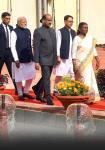Art of seduction. That is what advertising used to be. With an overdose of sermons on product and brand. Not anymore. Advertising is moving to be consumer centric rather than product.
Piyush Chauhan, 26, spends an hour everyday on the internet. Of this, he dedicates some time to the Axe Unlimited Academy, studying subjects that are tackily named, 'doll-itical science', 'physical education', and so on. Consumers like Chauhan are increasingly catching the attention of brand marketers.
That's because advertising is moving from focusing on the product to getting consumer centric. The Axe academy, if you have not already guessed, is an initiative by consumer goods major Hindustan Lever to tap consumers by communicating differently. In the website, you will see no obvious advertising on how good Axe is as a deodorant. Instead, the consumer is provided with contests with intermittent fun.
For its male deo brand Axe, HLL chose to set up a virtual academy to train young men. This was then linked with ground activities, where beyond lending the brand name, there was almost no direct communication on the product. Similarly, Pepsi's most recent cricket campaign talks about the Blue Billion with practically no reference to the cola.
This, according to professor and marketing consultant Jagdish Sheth, is a way forward for marketers.
"The communication needs to move from being product centric to being consumer centric," said Sheth who occupies the Charles H Kellstadt Chair of Marketing in the Goizueta Business School at Emory University.
Brand marketers seem to be taking his advice seriously. For instance, the recent initiatives taken by brands such as Sunsilk (blogs), Saffola (healthy heart foundation, weight loss challenge) and Wheel (ad- funded programme).
Punitha Arumugam, CEO, Madison Group, points out that such initiatives where the communication is focused on a particular initiative and not the product tends to result in higher brand recall. And very often, better sales too.
Last year, TVS Scooty initiated a campaign in Uttar Pradesh and Uttaranchal where on the basis of essays and then interviews, scholarships would be given to school girls to sponsor their further education. Over the two months that the campaign ran, the company saw 30 per cent increase in its sales in the region.
HLL too over the last three years has been undertaking a similar campaign under the Fair & Lovely Foundation.
The goodwill that the brand generates is an important factor in increasing sales, point out industry watchers.
Explaining why companies are increasingly moving away from traditional advertising, Rahul Welde, general manager-media, HLL, said that with the increasing clutter in the overall media space, it was important to find new ways communicate effectively with the consumer.
Sheth points out that with customer centric marketing is among the best ways of building brand loyalty among consumers. Once the user base has been established, the company can focus its communication activities on this group so as to maximise the returns from its advertising.
While doing this, it is important to maintain the link between the core proposition of the brand and the initiative.
Cadbury, which is trying to position itself as a substitute to Indian sweets on certain special occasions (weddings, celebrations), tied up with R-World at the time of the state board exam results last year.
Whenever a subscriber sent an sms to check his result, if he had passed, in addition to the result the message carried a line from Cadbury's ongoing ad campaign, Jab Pappu pass ho jaye, kuch meetha ho jaye.
Pranesh Mishra, president & COO, Lowe India, added that activities which involved creating any kind of community were also gaining pace with the spread of the internet.







 © 2024 Rediff.com -
© 2024 Rediff.com -